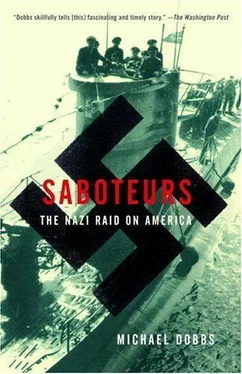Each of the agencies responsible for homeland defense had its own chain of command and jealously guarded its rights and prerogatives, some of which dated back to the War of Independence. Although War Department officials had tried to cut through the red tape and come up with a workable system of interagency cooperation, the people who actually patrolled the beaches, manned the coastal defense guns, and listened to enemy communications were barely on speaking terms with one another.
If there was one person in Washington who took the threat of internal subversion very seriously, it was President Franklin Delano Roosevelt. As assistant secretary of the navy during World War I, Roosevelt had been responsible for naval intelligence, and he constantly suspected the Germans of plotting attacks against American military installations. Some of these suspected plots were the figment of his own hyperactive imagination and lifelong fascination with the cloak-and-dagger, but others were real enough. In July 1916, saboteurs blew up a huge ammunition depot on Black Tom Island in New York Harbor opposite the Statue of Liberty, killing seven people and destroying two million pounds of munitions intended for Allied forces in Europe. 2It was the greatest explosion in the history of New York City, and could be heard in Philadelphia, nearly a hundred miles away. Thousands of heavy plate-glass windows fell out of skyscrapers and office buildings in Manhattan and Brooklyn, and pieces of shrapnel landed as far away as Governors Island. Six months later, in January 1917, the roar of exploding munitions again shook New York City, this time from a fire in a shell assembly plant near Kingsland, New Jersey.
Responsibility for the Black Tom and Kingsland explosions—which took place at a time when the United States was still officially neutral—was eventually traced to the German secret service. Among those implicated in the plot was Franz von Papen, a former German military attaché in Washington and future mentor to Adolf Hitler. It seemed reasonable to conclude that the Germans would try something similar in World War II.
Roosevelt’s suspicions were piqued by an intelligence report dated March 15, 1942, from the U.S. embassy in Switzerland warning that German submarines were transporting groups of “two or three agents at a time” to the coasts of north and central America. 3The report cited a trusted source who had just returned from the German port of Kiel, where he met with the relatives of U-boat men.
Agents carry communications and very valuable explosives… They are very familiar with area where they will work and very amply supplied with dollar bills obtained in Sweden and Switzerland. During darkness submarines proceed very near inshore (some commanders related having seen glare New York skyline), whence member submarine crew takes them ashore in hard rubber boats with outboard motors. Well developed plan prescribes that, at moment ordered, agents and accomplices in America will commence simultaneously everywhere on continent a wave of sabotage and terror, chief purpose of which is to cause United States military authorities to keep greatest possible number of troops on home front, reducing thereby to minimum number sent abroad.
The report was discussed by the Joint Chiefs of Staff on March 30, and passed on to the intelligence agencies “for appropriate action.” A week later, the president had his naval aide send a memorandum to the navy and the Coast Guard alerting them to the possibility of saboteurs coming ashore. An effective way of dealing with the threat, Roosevelt suggested, would be a “reasonable expansion” of the Coast Guard’s beach patrol service. 4In particular, he proposed equipping the one-man beach patrols with portable radio sets that would allow them instantly to alert their superiors to an enemy incursion. Two-way radio sets were a relatively novel innovation: Roosevelt had seen them used by the Secret Service at his country retreat at Hyde Park in upstate New York, and was much impressed.
As often happened with such missives, FDR’s suggestion about two-way radio sets was filed away and forgotten as one more passing presidential enthusiasm.
AGED TWENTY-ONE, with keen blue eyes, a ruddy complexion, and a deep wave in his hair, John Cullen had been working at Macy’s department store for just over a year when war broke out. As was the custom at Macy’s, he had started out delivering small packages and worked his way up to delivering furniture. His main interests outside work were bowling, dancing, and dates with his girlfriend.
The day after the Japanese attack on Pearl Harbor, Cullen and his best friend decided to enlist in the marines. They reported to a recruiting station in the Bronx, where a gruff sergeant told them, “If you fellas are ready to ship out tonight, we will take you. If not, leave now.” 5Their patriotic enthusiasm did not extend to missing Christmas with their families, so they joined the Coast Guard instead.
The Coast Guard was expanding rapidly to deal with the threat posed by German U-boats, and new recruits were sent to a receiving station on Ellis Island, where they were stacked in three-tier bunks. After several weeks’ training, they were dispatched to lifeboat stations along the East Coast for the unglamorous duty of “sand pounding”—walking up and down the beaches to look for ships in distress, drowning swimmers, and German submarines. The lifeboat stations were strung out some six miles apart from each other in a two-thousand-mile chain from Maine to Florida.
Cullen ended up in the little resort town of Amagansett, near the eastern tip of Long Island, on a stretch of coast known as the site of a large number of wrecks and groundings. A false sandbar a few hundred yards offshore had tricked numerous mariners over the years, stranding their boats as the tide washed out. A powerful hurricane had blown through Amagansett in 1938, flattening many beach houses and turning the area behind the seashore into half-empty scrubland.
The lifeboat station was a two-story wood-and-shingle building topped by a lookout tower, with a large boat room downstairs and sleeping quarters upstairs for sixteen men. When on beach duty, Cullen was required to walk or run three miles to a navigation beacon, punch a clock he carried with him to prove that he had reached his destination, and return to the station. At night, he had to make sure that every house facing the sea was completely blacked out. The six-mile circuit took about two hours to complete.
Coast Guard headquarters had responded to the alert for German saboteurs coming ashore by ordering simultaneous patrols on either side of the lifeboat station whenever practical. 6At the Amagansett station, however, the men only had one clock to share between them, so it was necessary to wait for a patrol to return before sending another out. This meant that each stretch of beach was patrolled twice in four hours, once on the way out and once on the way back.
The chance of a coastguardsman running into anyone coming ashore—assuming that the intruder spent roughly twenty minutes on the beach before moving inland—were approximately one in six.
ON THE night of Saturday, June 13, Cullen was assigned the midnight patrol east from Amagansett Lifeboat Station. The west patrol was late getting back, so Cullen did not leave until ten minutes past twelve. He made his way down from the lifeboat station through the sand dunes and past an observation tower and a naval radio station to the beach.
He was alone and unarmed, wearing the standard Coast Guard uniform of dark blue pullover, pants, and black dress shoes. He was unable to see more than a few yards in front of him because of the fog. There were rumors of German U-boats offshore but, even if he were to run into a Nazi sailor or saboteur, Cullen had no idea what to do or how to get help. Apart from a flare gun, he had no means of communicating with his lifeboat station.
Читать дальше












